September 13, 2016
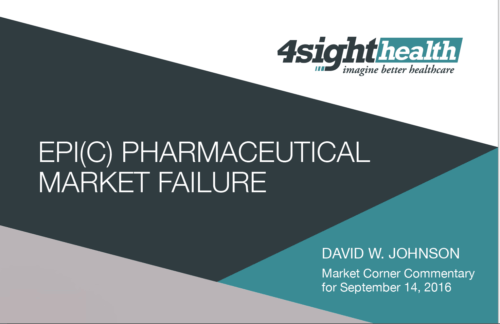
Epi(c) Pharmaceutical Market Failure
It was hard not to feel sorry for Mylan CEO Heather Bresch as she sat for an extended CNBC interview on the morning of August 25th. Clearly on the hot seat, Bresch tried to explain Mylan’s stratospheric EpiPen price increases. Despite limited product improvement, the retail price for EpiPen 2-Pak®has skyrocketed from $94 in 2007 when Mylan acquired the product to $608 today, a 550% increase.
Such unrestrained prices hikes are a clear example of market failure. Without competition, Mylan is free to charge what the market can bear. Regulatory barriers and opaque industry transfer pricing have created an untenable marketplace experience for consumers purchasing life-saving EpiPens.
Widespread consumer protests spurred Mylan into action. They’ve taken several steps to reduce the financial pressures on their customers. Americans shouldn’t have to take to the streets to demand fair drug prices. Price-gouging is on the rise. The U.S. government and industry representatives should develop pro-active policies for combatting pharmaceutical market failure.
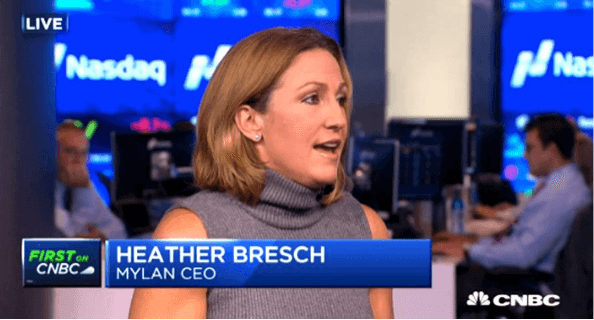
Heather Bresch on the Hot Seat
I’m sure Bresch wondered what had created all the fuss. Mylan had pushed through 25+% annual EpiPen price increases for years with minimal public reaction. Mylan’s last EpiPen price increase had occurred in May. Now late-August, the proverbial crap was hitting the fan.
Controversy built as parents purchased EpiPens for children heading back to school. Their collective sticker shock went viral with predictable outcomes. Politicians expressed outrage. Hillary Clinton called the price hikes “Outrageous.” Bernie Sanders posted the following on his Facebook page,
“The drug industry’s greed knows no bounds. There’s no reason an EpiPen, which costs Mylan just a few dollars to make, should cost families hundreds of dollars. The only explanation for Mylan raising the price by almost six times since 2008 is that the company values profits more than the lives of millions of Americans.”
Ouch! That morning (August 25th) The New York Times ran an editorial with the provocative title, “Another Drug Pricing Ripoff.” In very heavy trading, the company’s stock price had fallen 13% in the previous week. What was a CEO to do?
The daughter of West Virginia Senator Joe Manchin, Bresch is a public relations master. Calm, collected and engaging, Bresch stressed (“as a mother”) her determination to make EpiPens available to all who need them, particularly children, irrespective of price. She discussed her tireless efforts to expand access to EpiPens through legislative advocacy.
Bresch expressed empathy for consumers paying twice – higher insurance premiums and the very high retail prices. She announced that Mylan was tripling their cash rebates to $300. She further announced Mylan would produce a lower-cost generic EpiPen.
Bresch then went on the offensive. She decried the lack of transparency in drug distribution, displaying a supply-chain graphic that showed Mylan receives only $274 of the EpiPen’s $608 retail price (see chart below). Classic market intermediaries (PBMs, insurers, wholesalers and retail pharmacies) take the remaining $334. This represents a massive “system” tax on EpiPen consumption.
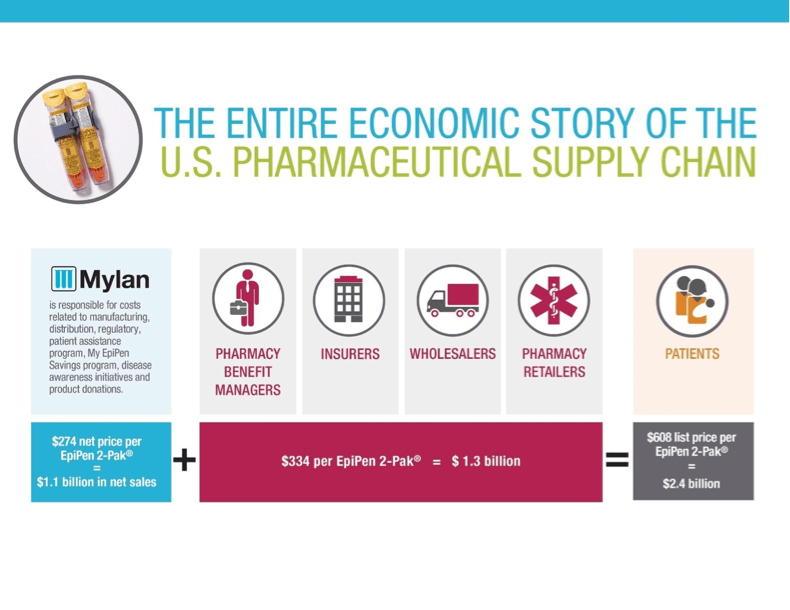
Bresch attempted to place Mylan’s pricing behavior within the broader context of the pharmaceutical industry’s flawed eco-system. She emphasized that the current opaque, balkanized drug distribution system “incentivizes higher retail prices for branded drugs.” She called on Congress to legislate more effective pharmaceutical regulation. On behalf of Mylan, she offered to do her share to fix the broken drug pricing and distribution systems drugs.
Heather Bresch is executing expert damage control as she attempts to pull Mylan out of its public relations “ditch.” Despite continued Congressional inquiry and threatened class-action suits, the company’s stock price has stabilized for now around $41 per share.
Her frenzied damage-control activities obscure the larger questions raised by Mylan’s EpiPen fiasco. These relate to the failure of regulatory and market forces to create reasonable supply-demand balance to check predatory pricing practices.
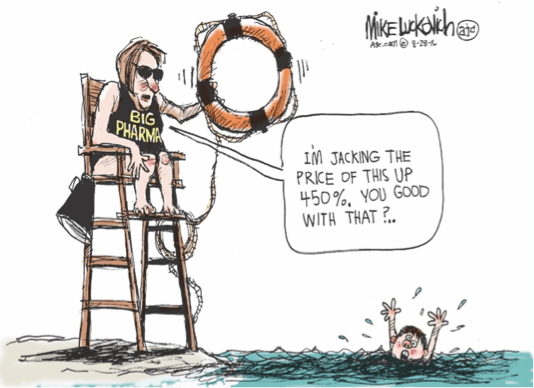
The Unspoken Truth
EpiPens are a terrific product. They’re safe, effective and demanded in ever-greater numbers. In a normal market, Mylan would drop EpiPens’ price to increase distribution. This strategy reduces per-unit profitability while generating greater sales volume and higher overall profitability. This was Walmart’s rationale for launching $4 generic drugs.
In EpiPens’ highly-regulated and non-competitive marketplace, Mylan has achieved the gravity-defying feat of simultaneously increasing prices and sales volume. Legislative actions have increased market demand for EpiPens even as their retail price soared. Not surprisingly, EpiPen profits for Mylan and system intermediaries have zoomed upward in lock-step with EpiPen’s rising price.
The one thing Bresch could not say was the fundamental economic truth regarding EpiPen pricing. Mylan has raised EpiPen’s retail price an astronomical 550% since 2007 years simply because it could. For a combination of regulatory, market and product development reasons, EpiPens have no real competition in the U.S., even as they come off-patent.
Essentially, Mylan can price EpiPens at whatever price the market can bear. Expecting them to do otherwise is equivalent to expecting foxes not to eat chickens. It’s simply not in corporations’ nature to forgo profits. The goal of market regulators is to keep corporate foxes out of vulnerable market henhouses through enlightened intervention.

Balanced Regulation
Not all markets are created equal. High-functioning markets have ample choice, ample supply, price transparency and minimal “friction” (e.g. intermediaries). Markets lacking these characteristics underperform and can even fail.
EpiPens are a clear example of market failure. Regulatory oversight has inhibited rather than enhanced competition. There is no price transparency as EpiPens make multiple supply-chain stops on their journey to customers. There are many greedy hands in the cookie jar.
Given the huge variation in health insurance coverage, component supply-chain prices and subsidy arrangements, customers have no idea what their out-of-pocket costs for purchasing EpiPens until they visit their retail pharmacy. Is it any wonder that consumers express outrage at EpiPen’s spiraling upward cost?
In the fullness of time, EpiPen’s gargantuan profit margins will entice competitors into the market and prices will fall. This is beginning to happen with Sovaldi, Gilead’s oral cure for Hepatitis C. Gilead prices Sovaldi at a $1000 per pill. Merck (Zepatier) and AbbVie (Viekira Rac) now offer lower-cost oral treatments for Hepatitis C. Unfortunately, waiting for markets to self-correct comes at a heavy cost to those who either forego vital medications or overpay for them.
When confronting market failure, regulators must intervene to establish appropriate supply-demand balance. Getting the intervention right is tricky. University of Chicago economist and current Governor of India’s Reserve Bank, Raghuram Rajan, observes that regulators must make “Goldilocks” market adjustments, “neither too hot nor too cold.”
In the pharmaceutical industry, this requires interventions that result in fair prices for branded drugs and offer sufficient return so pharma companies to continue funding breakthrough medical research. Society cannot afford to squelch discovery of the next Sovaldi, but it also cannot tolerate predatory pricing of vital medicines.
The solution to EpiPen market failure is rather easy. In Europe, 8 companies offer EpiPen-like products and competition among them keeps prices below $100. The Federal Drug Administration needs to accelerate entry of EpiPen competitors into the U.S. marketplace to temper Mylan’s exploitive pricing behavior.
Addressing other categories of pharmaceutical market failure (e.g. orphan drugs, specialty cancer drugs, repurposed drugs, etc.) require the same types of targeted and balanced regulatory interventions. Failure to address unrestrained pharmaceutical pricing practices undermines public confidence and invites public protests. Just ask Heather Bresch.
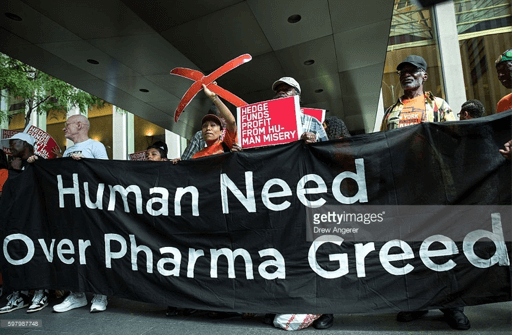
Avoiding the Pitchforks
There are strategies pharmaceutical companies can employ to temper consumer anger. Horizon Pharmaceutical, for example, places no income limitations on its financial assistance programs. If a patient’s insurance company won’t cover the cost of a Horizon drug, the company makes the drug available to those patients for free. While meritorious, Horizon’s financial assistance program and others like it do not address the very high total costs of branded drugs.
Despite generic drugs filling 90% of prescriptions, pharmaceutical costs are healthcare’s fastest-growing segment. Generic drugs are low-cost, in ample supply and easy to access. That means market failure and soaring costs emanate from branded drugs that constitute only 10% of filled prescriptions.
Capitalism relies on implicit consumer trust for effective market functioning. Rules, monitoring, enforcement and periodic adjustments are tools regulators use to ensure markets work well for both buyers and sellers.
As the EpiPen fiasco illustrates, elected representative respond forcefully to public protests. Pharmaceutical companies need to re-earn the public’s trust. Eliminating exploitive pricing policies and increasing intermediary pricing transparency are in their long-term interest.
In her CNBC interview, Mylan CEO Heather Bresch observed that pharmaceutical prices are at an “inflection point” and the “bubble is going to burst.” Her dramatic language captures the collective frustration generated by pharmaceutical market failure. There’s too much of it. It harms consumers.
It’s beyond time for Congress and the pharmaceutical industry to work together to improve drug approval and pricing mechanisms. Enlightened regulation fosters competitive markets and creates value for consumers – now and forever.





